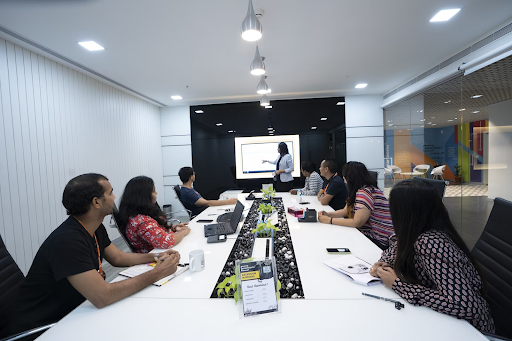
5 Astonishing Ways Of further developing Meeting Room Acoustics to Boost Efficiency
For most people, “acoustics” resonates with concert halls and other venues dedicated to theatrical and musical performances. However, while downplayed, acoustics significantly impact buildings other than performance venues, including workplace meeting rooms.
According to a research review on sustainable design and workplace productivity, noise is the number one impediment to workplace productivity. The review further highlights that noise at the workplace undercuts employees’ sense of control over their environment, impairs short-term memory, and elevates stress levels.
With the advent of remote and hybrid work models, acoustic solutions are crucial for meeting rooms to keep all team members on the same page. Below are tips for overcoming acoustic challenges in meeting rooms.
What is Acoustics?
One academic publication defines acoustics as the science of sound production, control, transmission, and effects through various mediums. Therefore, acoustics affect how individuals in a room interact with sound.
Many things happen in a meeting room to produce sound, including talking, typing, clicking, and murmurs, not to mention the sounds outside the meeting room and the office building. A meeting room with poor acoustics has poor sound control, resulting in reverberation effects.
Reverberation is when sound waves accumulate in space, causing auditory senses to perceive it long after production. It is a form of noise pollution because it is excessive or unwanted noise causing disturbance to humans and animals.
The noise pollution in meeting rooms with poor acoustics creates an inconducive work environment. However, you can overcome the acoustic challenges in a workplace meeting room by making the interior design modifications recommended below.
1. Install Soundproof Curtains And Drapes
Soundproof curtains help meeting room interior designers overcome acoustic challenges via sound absorption and proofing.
Sound absorption entails reducing acoustic challenges like reverberation and echos within a demarcated space. Sound exists as an energy form featuring vibrations that generate longitudinal waves.
The sound waves are omnidirectional, vibrating away from the source. However, the longitudinal sound waves move in the opposite direction when encountering an obstacle, forcing them to change directionality, akin to reflected light rays when they hit a shiny surface. The longitudinal sound wave reflection rate depends on the obstacle’s texture or porosity.
Porous surfaces like fabrics have large surface areas with numerous microscopic crevices that absorb the sound waves, limiting the reflected waves’ volume. On the other hand, hard, reflective surfaces like metallic and wooden office furniture reflect transmitted longitudinal sound waves with little to no absorption.
As stated, acoustic reverberation occurs when sound waves accumulate within a demarcated space. Sound wave accumulation occurs because, unlike unidirectional light waves, the waves travel in all directions, and more reflective surfaces in a room generate more waves.
However, soundproofing curtains and drapes or sound blankets can enhance acoustics by limiting the reflective surfaces in the room, minimizing the chances of reverberation.
On the other hand, acoustic curtains utilize the same sound wave principle in soundproofing. Therefore, they prevent sound waves propagated by external sources from entering a room.
The soundproofing factor in acoustic curtains is the core material which can be made from heavy wool, vinyl, or fiberglass. Also, the sound absorption or soundproofing level (measured in decibels) depends on the material used in the curtain’s core.
2. Drop Ceiling Tiles
While high ceilings create the illusion of an airy, more spacious room, they are bad for meeting room acoustics because they create a larger surface for longitudinal sound waves to bounce, causing sound wave accumulation.
Therefore, as the name suggests, drop ceiling tiles are acoustic enhancement installed to reduce the surface area available to reflect sound waves.
Besides decreasing a room’s height, drop tile ceiling manufacturers make the products using acoustic substrates/ materials, including fiberglass, polyester, mineral fiber, mineral wool, PET, and melamine foam. The highlighted substrates are fibrous and porous, creating the ideal longitudinal sound wave absorption surface.
3. Acoustic Baffles
Acoustic baffles are another type of ceiling-based acoustic treatment used to enhance the acoustics in a space. They differ from acoustic tiles in that the latter feature suspended baffles rather than creating a drop ceiling.
So, why choose acoustic baffles over drop ceiling tiles when both treatments reduce surface area? First, acoustic baffles are three-dimensional treatments creating a larger surface area for sound wave absorption than drop ceiling tiles that only facilitate absorption via the exposed surface.
Second, acoustic baffles are versatile. Technicians can install them in extremely large rooms or rooms that cannot accommodate other acoustic treatments due to limited wall space.
Third, acoustic baffles have the added benefit of aesthetic appeal and feature finishes with diverse aesthetic elements, including color and texture. Moreover, the finishes on the acoustic baffles may feature functional finishes to facilitate easy maintenance and durability.
4. White Noise Generators
While white noise generators are popular as sleep-inducing mechanisms, they can also help improve speech intelligibility in a meeting room.
White noise generators neither absorb nor block sound reverberation or echo. In contrast, they drown the ambient noises from such acoustic disturbances so that your ears only perceive the more palatable sound from the white noise machine.
5. Plush Furniture And Decor Elements
Besides soundproofing curtains, your interior designer can add other aesthetic elements that absorb sound. Such elements include floor rugs, carpeting, plush sofas, meeting pods, and acoustic wall panels. Moreover, one study shows that indoor tropical plants have effective soundproofing properties due to their dynamic movement and porous parts.
Conclusion
Speech intelligibility is crucial in creating a conducive workplace, particularly during meetings.
Therefore, consider using the tips above to improve meeting room acoustics and eliminate workplace stress and frustration to facilitate accurate communication and improve productivity.







